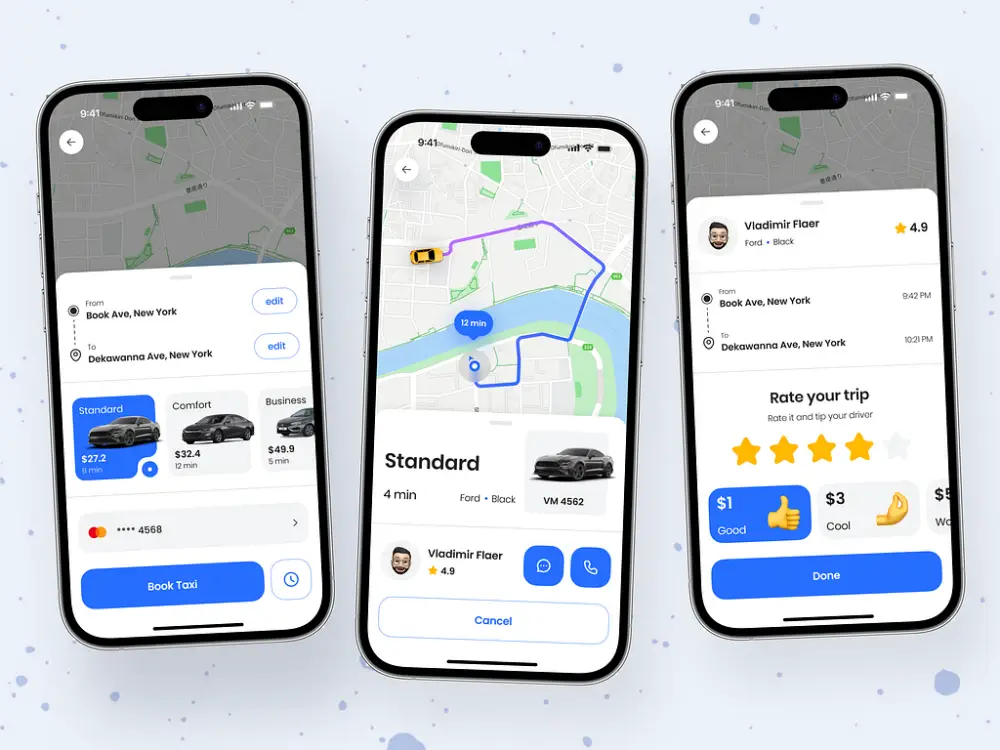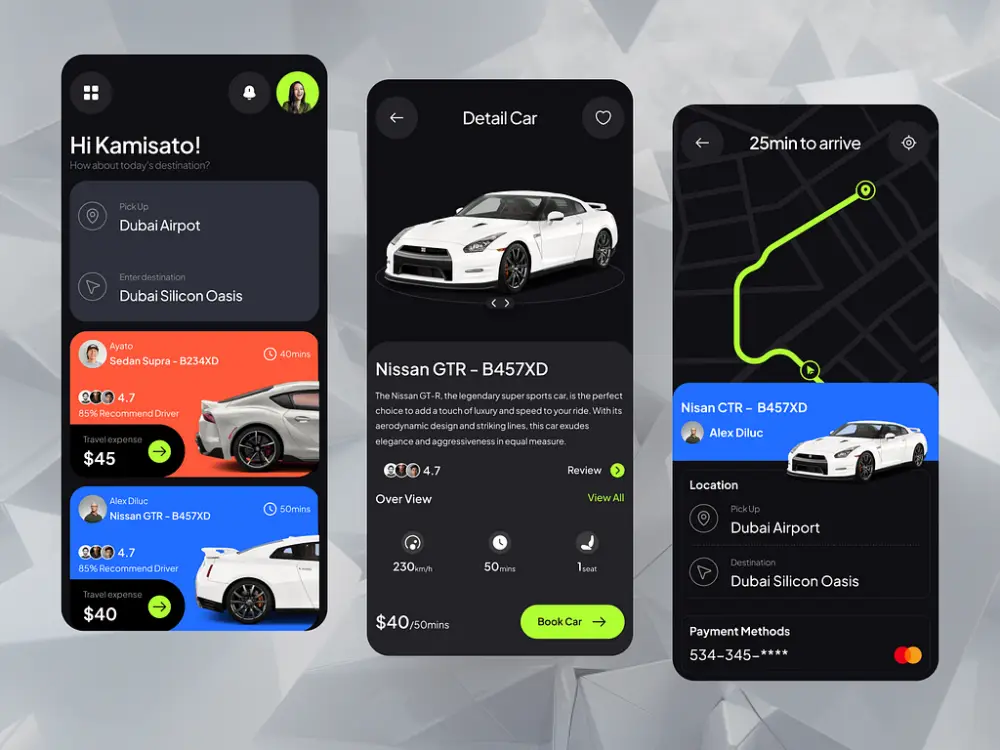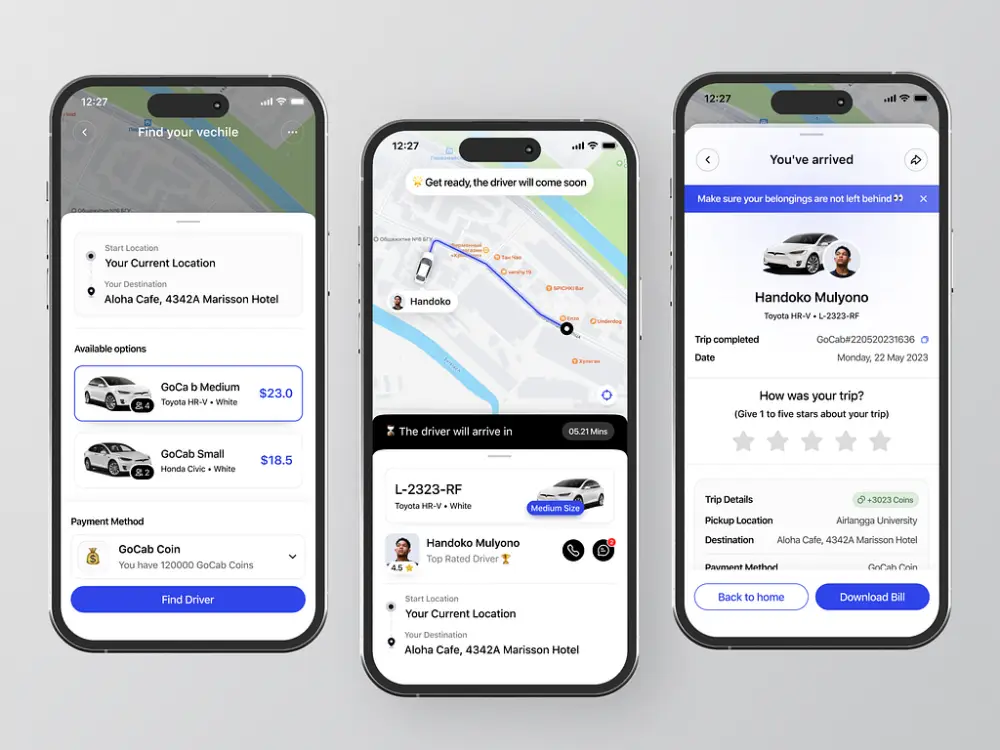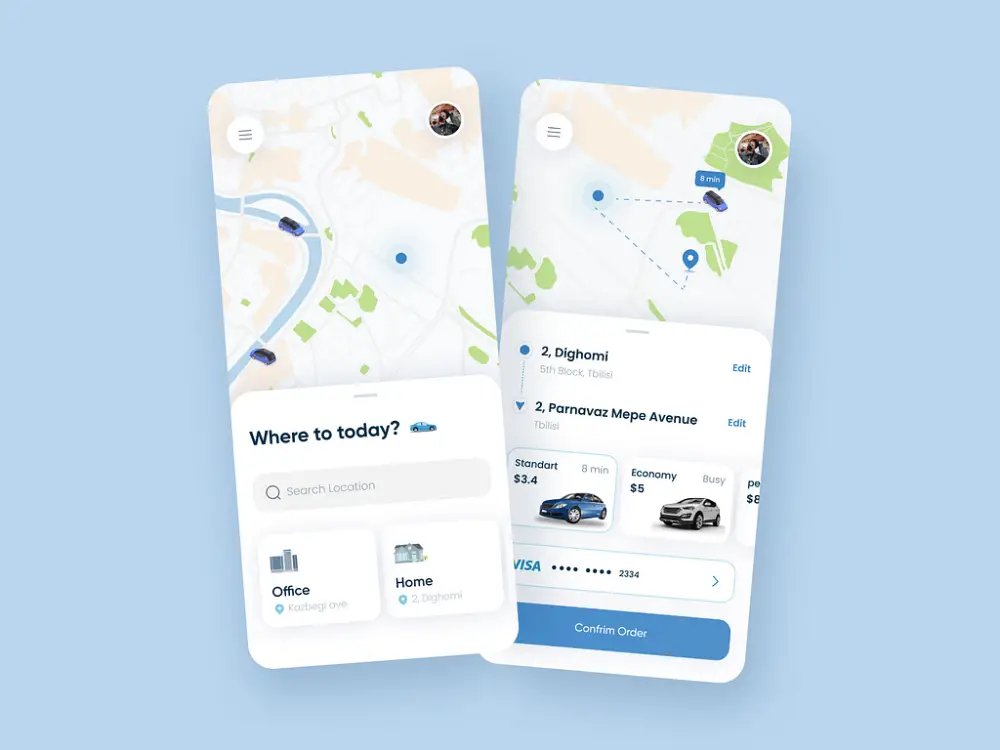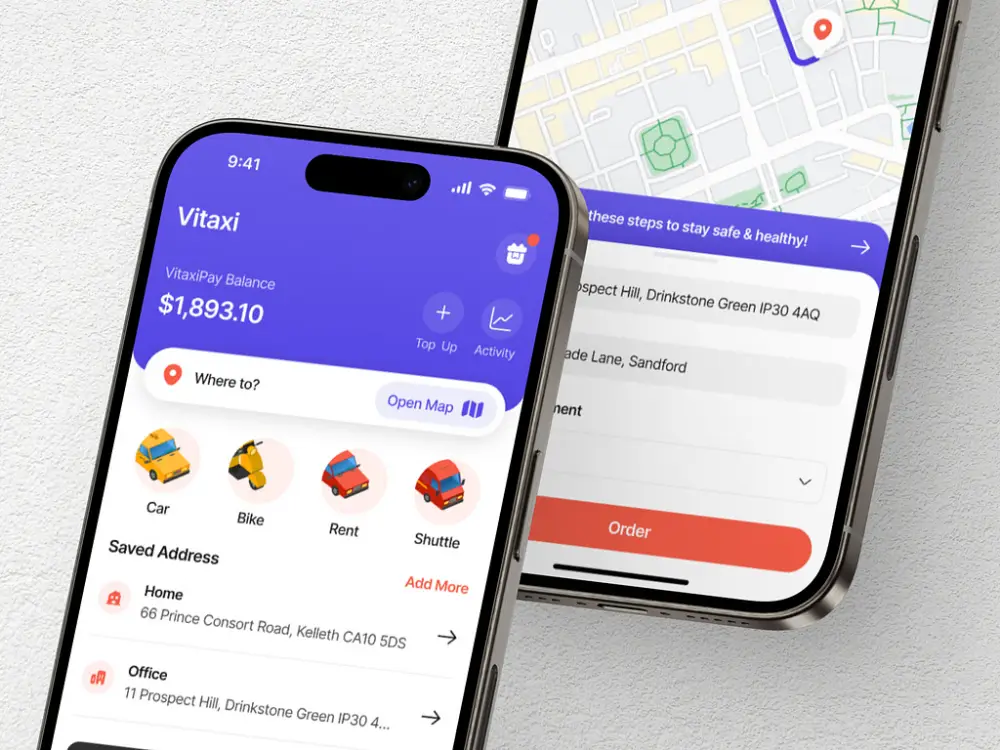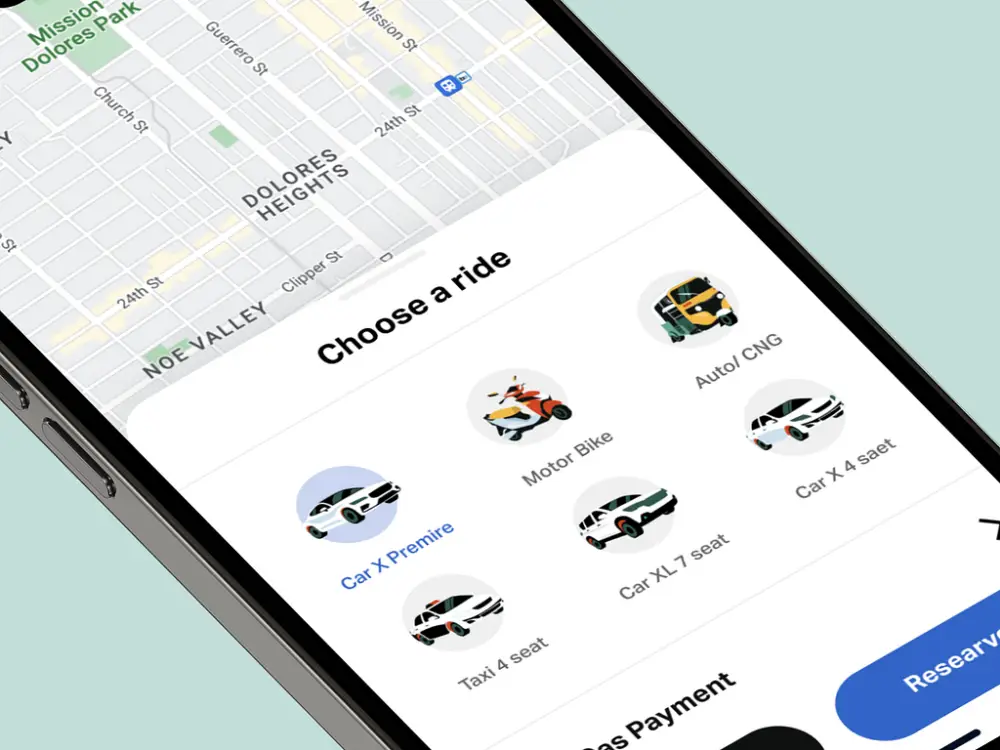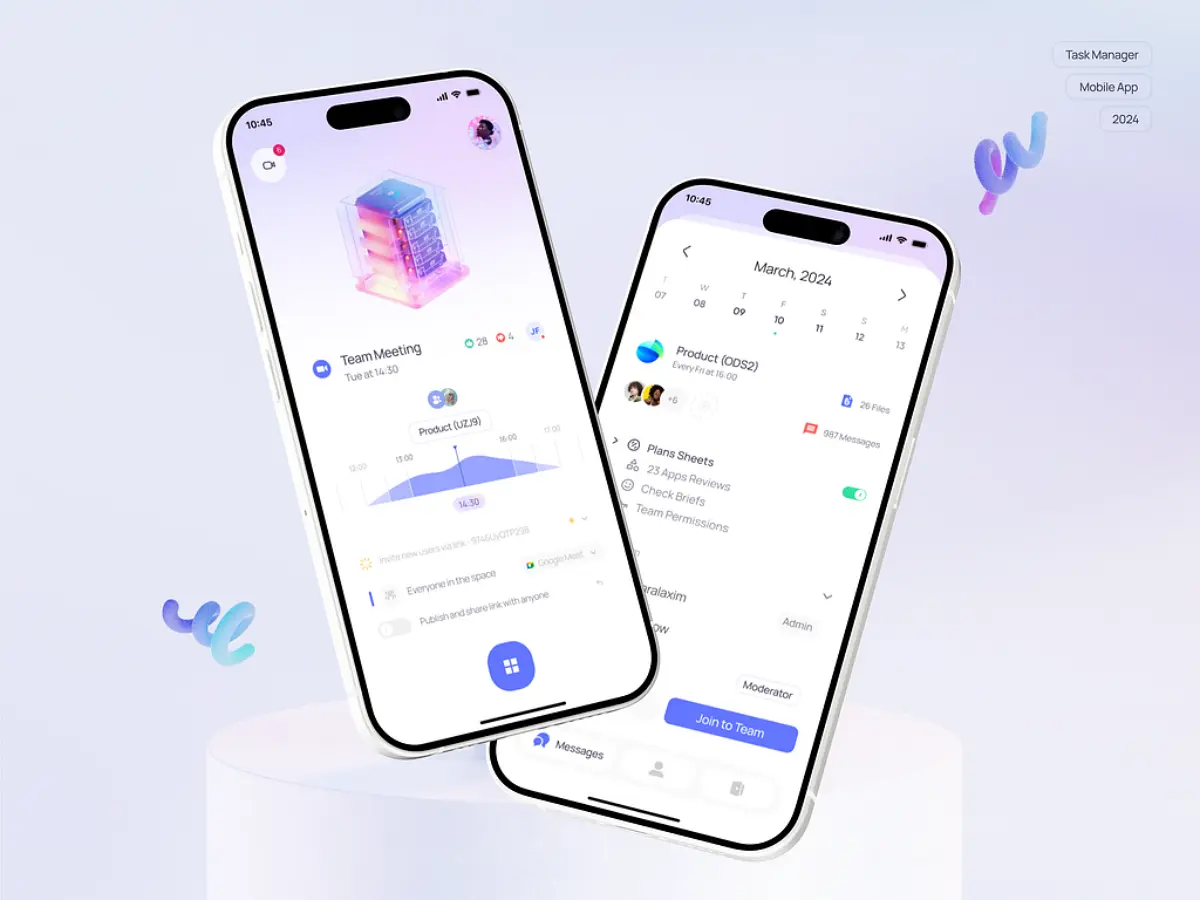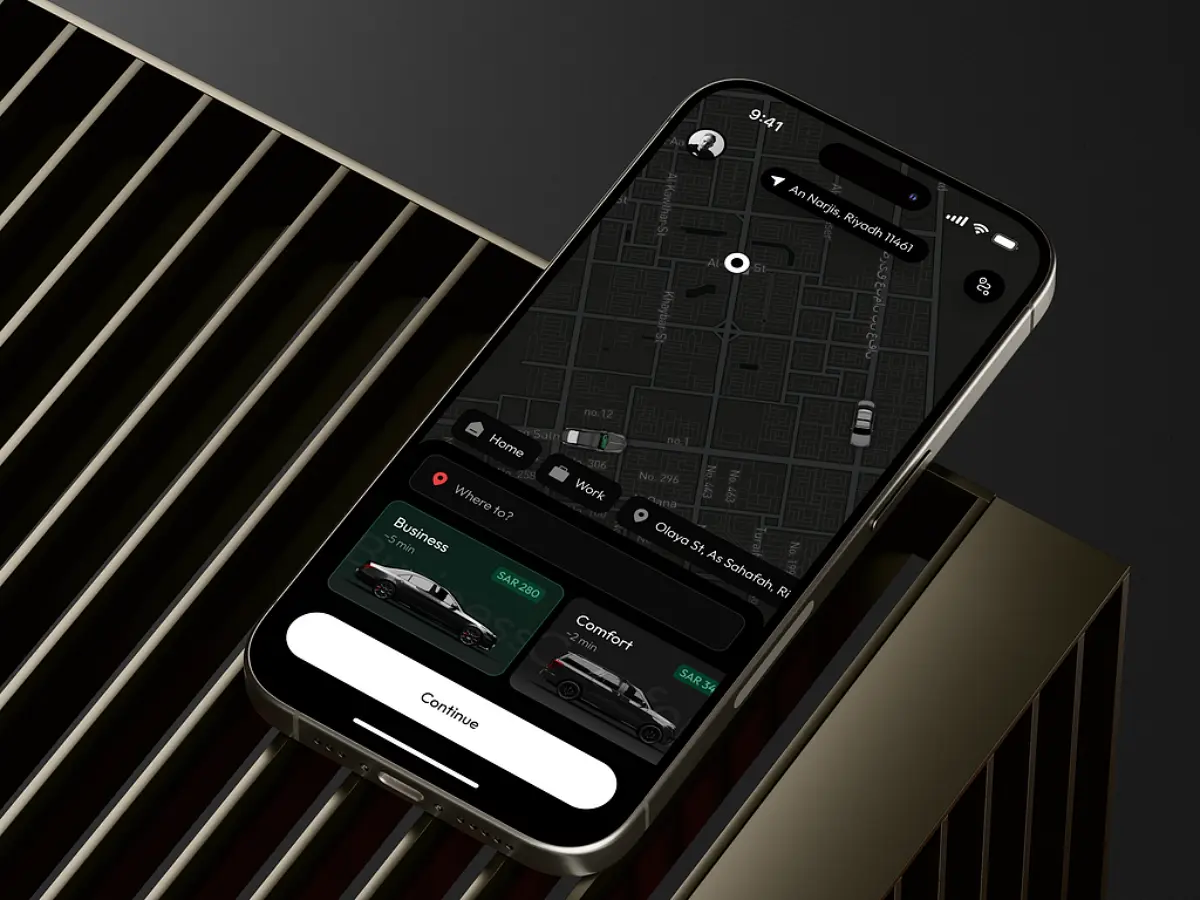Your Go-To Guide For Taxi Booking App Development: Features, Monetization, Cost
- TECHVIFY Team
- 0 Comments
Picture this: It’s a rainy Friday evening. You’ve just wrapped up a long day at work and are eager to get home, slip into something comfortable, and binge-watch your favorite series. You step out, and there it is – a long line of people, all waiting for a cab, just like you. Frustrating, right?
Now, imagine if you could whip out your smartphone, tap a few times, and have a ride at your doorstep in minutes. That’s the magic of taxi booking apps. In today’s fast-paced world, these apps have become as essential as our morning coffee. They’ve seamlessly integrated into our lives, offering convenience, safety, and efficiency at our fingertips.
Starting a ride-hailing service now is not just a great idea; it’s a brilliant one. The demand for reliable and quick transportation is soaring, and people are consistently looking for smarter, hassle-free ways to navigate their busy lives. With a taxi booking app, you’re not just providing a service; you’re offering an experience – one that saves time, reduces stress, and brings a smile to people’s faces, even on the rainiest of days.
In this article, TECHVIFY Team will take you through the exciting journey of developing a taxi booking app. From the initial spark of an idea to the intricate details of design and development, let’s explore how you can create an app that becomes an indispensable companion for every smartphone user.
Ready to embark on this ride? Buckle up, and let’s get started!
1. What is a Taxi Booking App?
A taxi booking app is a mobile application that enables users to book a ride quickly and conveniently using their smartphones. By leveraging GPS technology, the app identifies the user’s current location and connects them to available drivers nearby. Users can then enter their desired destination, choose the type of vehicle they prefer, and confirm their booking. The app provides an estimated time of arrival and fare, making the entire process transparent and efficient.
In essence, a taxi booking app transforms the traditional process of hailing a cab into a streamlined, user-friendly digital experience.
A Seamless Connection
At its core, a taxi booking app connects passengers with drivers who are available in their vicinity. The app uses GPS to pinpoint the user’s location, show nearby drivers, and estimate the time of arrival. It’s like having a digital bridge that instantly links those in need of a ride with those ready to provide one.
Features That Make Life Easier
These apps come packed with features designed to make the whole process smooth and hassle-free:
- Real-time Tracking: Passengers can track their ride in real-time, ensuring they know exactly when their driver will arrive.
- Cashless Payments: With integrated payment systems, users can pay through the app using credit/debit cards, digital wallets, or even cryptocurrencies.
- Ride History: Users can view their past trips, making it easy to keep track of travel expenses.
- Ratings and Reviews: Both drivers and passengers can rate each other, fostering a community of trust and reliability.
The Tech Behind the Magic
Behind the scenes, a taxi booking app is a symphony of advanced technologies:
- GPS and Navigation Systems: For accurate location tracking and route planning.
- Secure Payment Gateways: To ensure all transactions are safe and secure.
- Machine Learning: For smart matching of drivers and passengers based on various factors like location, traffic, and demand.
Why They Matter
Taxi booking apps have revolutionized urban transportation. They’ve made getting around cities faster, safer, and more convenient. Gone are the days of waving down a cab in the street or calling a dispatch center. With a taxi booking app, your ride is just a tap away, making it an indispensable tool for modern living.
Have a Project Idea in Mind?
Get in touch with experts for a free consultation. We’ll help you decide on next steps, explain how the development process is organized, and provide you with a free project estimate.
2. Types of Taxi Apps and Features To Consider
When it comes to taxi booking apps, there are two primary types designed to cater to different users: the app for passengers and the app for drivers. Each type serves a unique purpose and is packed with features that ensure a smooth and efficient experience for both parties.
App for Passengers
The passenger app is designed to make the process of booking a ride as straightforward and convenient as possible. It includes features that allow users to sign up, create profiles, book rides, track their journey in real-time, calculate fares, choose multiple payment options, review ride history, rate drivers, and communicate directly with drivers through the app.
| Feature | Description |
| User Registration and Profile Management | Allows users to sign up, create profiles, manage personal information, and add payment methods. |
| Ride Booking Interface | Enables passengers to enter pickup and drop-off locations, choose vehicle type, and see an estimated fare. |
| Real-time GPS Tracking | Lets passengers track the exact location of their ride from booking until arrival at the destination. |
| Fare Calculation | Provides an upfront estimate of the ride cost based on distance, travel time, and traffic conditions. |
| Multiple Payment Options | Supports various payment methods such as credit/debit cards, digital wallets, and cash. |
| Ride History | Keeps a log of all past rides, allowing passengers to review and track their travel expenses. |
| Ratings and Reviews | Enables passengers to rate their drivers and provide feedback based on their ride experience. |
| In-app Communication | Allows passengers to contact drivers directly through the app via calls or messages for better coordination. |
| Vehicle Preferences | Allows passengers to choose their preferred type of vehicle for the ride. |
| Promo Code | Enables passengers to enter promo codes for discounts on their rides. |
| Fare Splitting | Allows passengers to split the fare with other riders directly through the app |
| Multiple Bookings | Enables passengers to book multiple rides in advance or for different destinations. |
Learn More On:
App for Drivers
The driver app is engineered to help drivers manage their rides efficiently while ensuring a smooth experience for passengers. It includes features that allow drivers to register and verify their identity and vehicle details, receive and accept ride requests, navigate and optimize routes using integrated GPS, track their earnings, review ride history, rate passengers, and communicate directly with passengers through the app.
| Feature | Description |
| Driver Registration and Verification | Allows drivers to register and verify their identity and vehicle details, including necessary documents. |
| Ride Requests and Acceptance | Enables drivers to receive and accept ride requests from nearby passengers. |
| Navigation and Route Optimization |
Provides drivers with the best possible routes using integrated GPS and mapping services. |
| Earnings Tracker | Displays daily, weekly, and monthly earnings with detailed breakdowns of completed rides and bonuses. |
| Ride History | Keeps a log of all completed rides, allowing drivers to review their trips for record-keeping and performance monitoring. |
| Ratings and Reviews |
Enables drivers to rate passengers and provide feedback based on their ride experience. |
| In-app Communication |
Allows drivers to contact passengers directly through the app via calls or messages for better coordination. |
| Availability Status |
Allows drivers to set their availability status (online/offline) to control when they receive ride requests. |
| Trip Scheduling | Enables drivers to schedule trips in advance, allowing for better planning and time management. |
| Driver Dashboard | Provides a comprehensive overview of driver performance, including ride statistics, earnings, and customer feedback. |
| Emergency Assistance |
Offers a quick-access feature for drivers to request help or report emergencies directly through the app. |
| Fuel and Maintenance Log |
Allows drivers to keep track of fuel expenses and vehicle maintenance records. |
Admin Panel
The admin panel is the central hub for managing all aspects of the ride-hailing service. It includes tools and features that allow administrators to oversee operations, monitor performance, and ensure smooth functioning of the app for both passengers and drivers.
| Feature | Description |
| Trips/Rides Management | Allows admins to view completed, canceled, rejected, or missed trips. This helps track driver performance and take necessary actions. |
| Real-Time Analytics | Enables admins to analyze real-time app performance, including the number of active taxis and current app usage. |
| Wallet Management | Allows the admin to manage the wallet and distribute earnings to drivers based on their rides. |
| Automatic Mileage Tracking | Facilitates tracking the mileage of the fleet, helping identify low-performing cars to reduce repair costs. |
| User Management | Enables the admin to manage both riders and drivers efficiently without disrupting the app’s performance. |
| Track Rides | Allows the admin to track ongoing rides and locate them in case of an emergency. |
| Revenue Reports | Enables the admin to generate revenue reports using the dashboard and take necessary actions. |
| Fare Management | Allows the admin to adjust fares based on demand and manage pricing efficiently. |
| Geolocation Boundary Management | Enables the admin to define and manage geographic boundaries, restricting app functionality to specific areas. |
| Promocode / Discounts | Allows the admin to offer discounts and promocodes to riders based on their transaction history to enhance user experience. |
Ready to Develop Your Taxi Booking App?
Contact TECHVIFY’s experts for a free consultation. We’ll guide you through the development process, answer your questions, and provide a free project estimate.
3. Advanced Features To Be Included In A Taxi Booking App
In the bustling world of taxi booking apps, staying ahead of the competition is no small feat. However, by integrating unique and advanced features, you can elevate your app to new heights and captivate a broader audience. Let’s dive into some must-have features that can give your app a competitive edge, all powered by the magic of Artificial Intelligence (AI).
3.1. Bill Splitting
Imagine you and a friend sharing a ride and effortlessly splitting the fare. With the bill-splitting feature, your app can make this a reality. By allowing both riders to pay separately, it keeps transactions transparent and hassle-free. This not only encourages group rides but also enhances user satisfaction by simplifying the payment process.
3.2. AI-Driven Route Optimization
Traffic jams can be a real headache, but your app can come to the rescue with AI-driven route optimization. This feature helps users navigate real-time traffic conditions and choose the best routes to their destinations. By reducing travel time and offering efficient route suggestions, you can significantly improve the user experience.
3.3. Travel Time Prediction
Predicting travel times can be tricky, but not with AI on your side. By analyzing historical patterns and current weather conditions, AI can provide users with accurate travel time estimates. This feature not only enhances planning but also boosts user satisfaction by offering reliable information.
3.4. AI-Driven Customer Data Analytics
Data is powerful, and AI can make it even more so. By analyzing past user data, AI can identify trends and areas for improvement, helping app owners optimize performance. This means informed strategic decisions and a better overall user experience, all thanks to the insights provided by AI.
Learn More On:
3.5. Demand Forecasting
Imagine knowing exactly when and where your services will be in high demand. With AI’s predictive analytics, demand forecasting becomes a breeze. Admins can dynamically adjust fares based on peak hours and demand patterns, maximizing revenue and ensuring efficient pricing strategies during busy times.
3.6. AI Chatbots and Virtual Assistance
Customer support is essential, but it doesn’t have to be costly. By embedding AI chatbots and virtual assistants, your app can automate customer support, answering queries and resolving issues without the need for additional staff. This not only reduces operational costs but also ensures users receive timely and efficient support.
3.7. Smartwatch Access
In today’s fast-paced world, convenience is key. With smartwatch access, users can book rides and make payments seamlessly from their wearable devices. This modern and flexible access option enhances convenience and attracts tech-savvy users, keeping your app at the forefront of innovation.
3.8. Blockchain
Security is paramount, and blockchain technology can provide the ultimate safeguard for user data. By implementing blockchain, you can protect user information from hackers, ensuring privacy and boosting customer loyalty. This builds trust and reliability, crucial elements for any successful app.
By weaving these advanced features into your taxi booking app, especially those driven by AI, you can create a standout experience that not only meets but exceeds user expectations. Your app will not only survive but thrive in the competitive market, offering unparalleled convenience, efficiency, and security.
Let’s talk
A consultation with the Client Relationship Manager, who represents TECHVIFY, without any commitment from your side, will give you:
- Structured and clear vision of your future application
- Information about how our software development company guarantees 100% on-time and on-budget delivery
- Recommendations for choosing the tech stack
- Advice on further steps
- Business-side recommendations
- Rough project estimation on software development
TECHVIFY is right where you need. Contact us now for further consultation:
4. Monetization Strategies for Your Taxi Booking App
The ride-hailing market is booming and shows no signs of slowing down. With substantial growth projected globally, it’s an opportune time to tap into this high-demand industry. Here are some compelling statistics from Statista to consider:
- The global ride-hailing market is anticipated to grow significantly, with revenue expected to hit US$167.60 billion by 2024.
- An annual growth rate (CAGR 2024-2029) of 4.89% is projected, leading to a market volume of US$212.80 billion by 2029.
- User numbers are set to soar, with the market expected to serve 2.31 billion users by 2029.
- User penetration is projected to be 23.1% in 2024, increasing to 28.6% by 2029.
- The average revenue per user (ARPU) is estimated at US$93.59.
- The ride-hailing market operates exclusively online.
- China is poised to lead the market with a projected revenue of US$59.56 billion in 2024, making it the top revenue-generating country globally.
- In the United States, ride-hailing companies face increased scrutiny and regulation, resulting in market consolidation and higher prices.
With these promising statistics, it’s clear that the ride-hailing market offers lucrative opportunities. Now, let’s delve into various monetization models to maximize your app’s revenue.
4.1. Commission-Based Model
One of the most popular monetization strategies is the commission-based model, where the app takes a percentage of each transaction between drivers and riders.
- Revenue Share: Earn a commission on every ride booked through the app.
- Driver Incentives: Encourage drivers to complete more rides by offering performance-based incentives.
- Flexibility: Adjust commission rates based on factors like demand, location, and time of day.
4.2. Subscription Model
A subscription model can be highly effective, providing a steady stream of revenue by charging drivers or users a recurring fee for access to premium features.
- Premium Access: Offer advanced features such as priority bookings, enhanced driver support, and exclusive discounts.
- Steady Income: Generate consistent revenue through monthly or yearly subscription fees.
- User Loyalty: Increase user retention by providing valuable services that justify the subscription cost.
4.3. Surge Pricing
Surge pricing involves increasing fares during peak demand times, maximizing revenue when the need for rides is high.
- Dynamic Pricing: Adjust fares in real-time based on demand and supply conditions.
- Increased Profits: Capitalize on high-demand periods to boost earnings.
- User Adaptation: Educate users about the benefits of surge pricing, such as quicker ride availability during peak times.
4.4. Advertising
Leverage the app’s user base by displaying targeted advertisements, offering an additional revenue stream.
- Targeted Ads: Utilize user data to display relevant ads, enhancing click-through rates.
- Partner Promotions: Collaborate with local businesses to promote their services within the app.
- Non-Intrusive: Ensure ads are seamlessly integrated into the user experience to avoid disruption.
4.5. In-App Purchases
Offer in-app purchases for added convenience and enhanced user experience.
- Premium Features: Allow users to unlock advanced features like no-wait rides or preferred driver selection.
- Merchandise: Sell branded merchandise or ride-related accessories through the app.
- Service Upgrades: Provide options for service upgrades, such as luxury vehicle selection or ride-sharing passes.
4.6. Extra Services
Expand your app’s functionality by including additional services like package delivery, grocery delivery, and food delivery. This approach can turn your taxi booking app into a versatile super app, similar to platforms like Grab and Uber.
- Package Delivery: Offer quick and reliable delivery services for documents and parcels.
- Grocery Delivery: Partner with local grocery stores to deliver groceries directly to users’ doorsteps.
- Food Delivery: Integrate a food delivery service, allowing users to order from their favorite restaurants.
Learn More On:
5. The Journey of Developing a Taxi Booking App
Embarking on the adventure of developing a taxi booking app is like setting sail on an exciting voyage. Each step is crucial, from charting your course to reaching your destination. Let’s dive into this journey, ensuring you’re well-prepared for every twist and turn along the way.
5.1. Market & Competitor Research
Every great adventure starts with a solid plan. Before you even think about coding, you need to know the lay of the land. Conduct thorough market research to understand the current landscape and identify potential opportunities. Study your competitors closely; what are they doing right, and where are they falling short? This knowledge will be your compass, guiding you toward creating an app that stands out in a crowded marketplace.
- Understand Trends: Identify current market trends and user preferences.
- Benchmark Competitors: Analyze strengths and weaknesses of existing apps.
5.2. Detailed Plan and Timeline
With your research in hand, it’s time to map out your journey. Define your Unique Selling Proposition (USP) and outline your revenue model. Will you use a commission-based approach, a subscription model, or perhaps a hybrid? Break down the development process into manageable milestones, setting a realistic timeline for each. This roadmap will keep your project on track and ensure you don’t lose sight of your goals.
- Define USP: Clearly articulate what sets your app apart.
- Set Milestones: Establish a timeline with specific development phases.
5.3. Finding a Suitable Vendor
Choosing the right partner for your journey is crucial. Enter TECHVIFY, Vietnam’s leading AI & Software Solution provider. With strong consulting capabilities, TECHVIFY can help you refine your ideas and develop a top-tier app. They also specialize in implementing state-of-the-art GenAI-powered solutions to supercharge your business. With TECHVIFY by your side, you’ll have the expertise and innovation needed to bring your vision to life.
- Expert Consultation: Benefit from TECHVIFY’s robust consulting services.
- Innovative Solutions: Leverage GenAI-powered technology to enhance your app.
5.4. UI/UX Design
Your app’s design is its personality, its story told in pixels and colors. Define a compelling narrative for your brand and let it guide your design choices. Focus on creating an intuitive, user-friendly interface that delights users at every touchpoint. Remember, a captivating design isn’t just about aesthetics – it’s about crafting an experience that users will love and remember.
- Brand Story: Create a cohesive narrative that reflects your brand.
- User-Centric Design: Ensure the interface is intuitive and engaging.
5.5. Building the MVP
With your design in place, it’s time to build the Minimum Viable Product (MVP). This initial version of your app should include the core features necessary to function and attract early users. Think of the MVP as your ship’s maiden voyage; it’s a chance to test the waters and gather valuable feedback before committing to a full-scale launch.
- Core Features: Focus on essential functionalities for early testing.
- User Feedback: Gather insights from initial users to refine the app.
5.6. Testing
Before you set sail for the open sea, thorough testing is essential. Conduct rigorous quality assurance to identify and fix any bugs or issues. Test your app across different devices and operating systems to ensure a seamless user experience. This phase is about ensuring your ship is seaworthy, ready to handle whatever comes its way.
- Quality Assurance: Perform extensive testing to eliminate bugs.
- Cross-Platform Testing: Ensure compatibility across various devices and OS.
5.7. Deployment
With testing complete, it’s time to launch your app into the world. Deploy your app on relevant platforms like iOS and Android, and ensure it’s easily discoverable by potential users. This is the moment your hard work pays off as users start downloading and engaging with your app.
- Platform Release: Deploy on major platforms such as iOS and Android.
- Visibility: Optimize app store listings for better discoverability.
5.8. Maintenance and Support
The journey doesn’t end with deployment. Continuous maintenance and support are vital to keep your app running smoothly. Regular updates, feature enhancements, and prompt customer support will keep users happy and loyal. Think of this phase as ongoing navigation and upkeep, ensuring your ship remains in top condition and continues to deliver a stellar experience.
- Regular Updates: Keep the app fresh with new features and improvements.
- Customer Support: Provide timely assistance to address user issues.
Learn More On:
6. The Cost of Taxi Booking App Development
Understanding the cost of developing a taxi booking app is crucial for budgeting and planning. Here are the main factors that influence the overall cost:
App Complexity:
- Basic Version: Includes essential features like user registration, booking, payment integration, and basic GPS tracking.
- Advanced Version: Incorporates additional features like real-time tracking, in-app chat, advanced analytics, and AI-driven recommendations.
Platforms:
- Single Platform: Developing for either iOS or Android can lower costs.
- Cross-Platform: Building for both iOS and Android increases costs but broadens your market reach.
Features:
- Core Features: User and driver registration, booking and dispatch, payment gateway, and notifications.
- Advanced Features: Real-time tracking, in-app messaging, multi-language support, and AI-powered route optimization.
Region of Development:
- US and Europe: Higher development costs due to higher labor rates.
- Vietnam (TECHVIFY): TECHVIFY’s software engineers from Vietnam offer the best quality without breaking the bank. The cost can be up to 60% cheaper than hiring US software engineers, providing excellent value for your investment.
TECHVIFY – Global AI & Software Solution Company
From Startups to Industry Leaders: TECHVIFY prioritizes results, not just deliverables. Accelerate your time to market and see ROI early with high-performing teams, AI (including GenAI) Software Solutions, and ODC (Offshore Development Center) services.
- Email: [email protected]
- Phone: (+84)24.77762.666




